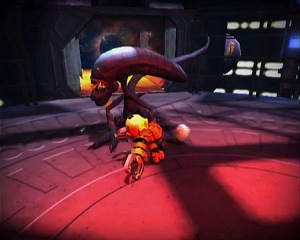 Your audience might mistake you for the new kid on the game development block, but you’ve actually worked on franchises that are bound to be familiar to longtime gamers. Tell us about some of the highlights of your time at Rare, and what your responsibilities were during those projects.
Your audience might mistake you for the new kid on the game development block, but you’ve actually worked on franchises that are bound to be familiar to longtime gamers. Tell us about some of the highlights of your time at Rare, and what your responsibilities were during those projects.
I was at Rare for eight years, working on five released games and several prototypes. I started as a junior artist (weapons and vehicles for Conker), then moved on to environment artist (Conker, Banjo, Kinect Sports 2), technical artist (essentially writing software to support the other artists), and UI artist (Kinect Sports 1 and 2, creating the front end graphics, menus, buttons, etc). Conker: Live and Reloaded is still my favourite project. It was a great game, a great team, and it was my first game so I was still a bit in awe of landing such a cool job.
We’ve seen a lot of devs move from big companies to the indiesphere for the sake of creative freedom. Would you say that’s the case for you as well?
Yes, I was really looking for something different, and it just seemed like the perfect time to set up as an indie. I’d accumulated enough different skills that I decided I could handle development on my own, and the freedom of being my own boss, and deciding exactly what direction to go in, was very attractive.
 That had to be a major life transition – how did you prepare for it? Do you find yourself doing a ton of independent contract work and developing your dream games during after-hours?
That had to be a major life transition – how did you prepare for it? Do you find yourself doing a ton of independent contract work and developing your dream games during after-hours?
I actually left Rare as a permanent employee very abruptly, but was immediately rehired as a contractor on Kinect Sports 2 for six months. It worked out really well as it gave me a chance to figure out exactly what I wanted to do, and time to set up Don’t Step On The Cracks before I had the worry of not having a pay check! Since that contract finished I’ve been working as DSOTC 100%. I want to give it the best chance to succeed and I don’t think I’d be able to do that if I was splitting my time across different jobs.
So what inspired the premise of your first iOS game, On The Wind? Were you ever caught in the middle of a windstorm, saw leaves blowing around, and said, “Ah yes, I must do a game about this”?
There was never a moment of epiphany; it just really coalesced from years of playing and thinking about games. Whenever I’m playing something my mind is thinking about what parts I like, what’s wrong with it, how could I make it better or make it unique. The idea for leaves in the wind really comes from looking into Boids and flocking systems. With a few simple rules you can get some beautiful and complex motion evolving, and I was just trying to come up with a unique way to use those ideas. The gameplay is similar to many endless runner-style games, but it was ‘The Helicopter Game’ that stuck with me many years ago. It just has the perfect combination of simplicity and challenge.
 How long did On The Wind’s development cycle last, and what ended up being the most challenging part of the process? In hindsight, do you feel you were prepared to create a game from start to finish all on your own?
How long did On The Wind’s development cycle last, and what ended up being the most challenging part of the process? In hindsight, do you feel you were prepared to create a game from start to finish all on your own?
Development has taken around six months up until release, although this is quite a bit longer than I think it should have taken. I think the most challenging aspect wasn’t so much to do with actual development, but was with being self employed and working from home for the first time. I found it very easy to sit and do “research” (i.e. play games) all day! Although there were a lot of things to learn (and still to learn), spending eight years making games, and seeing others make games beforehand, was about the best preparation I could get.
Did you use an out-of-the-box game engine for On The Wind or did you create your own from scratch?
I’m actually using the Unity engine; I played around with all the major engines and frameworks, trying to find one that would suit my skills and the games I wanted to make, and Unity seemed to provide the most features while still being flexible enough to create whatever I could think of.


